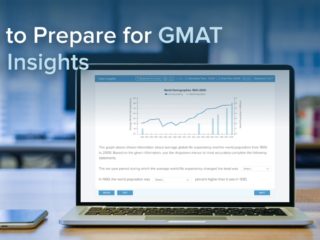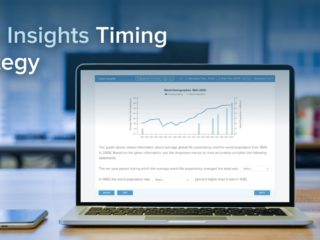| Getting your Trinity Audio player ready... |
Last Updated on June 10, 2023
As you’ve probably heard, the Graduate Management Admissions Council (GMAC) is releasing a new version of the GMAT called the GMAT Focus Edition. That new GMAT will include a new section: Data Insights.
The thing is, content-wise, GMAT Data Insights is not actually so new. Rather, it is made up of various parts of the current GMAT exam. In this article, we’ll explore exactly what GMAT Data Insights is, the question types you’ll see in this “new” section, and how to leverage the Data Insights section to increase your GMAT score.
Here are the topics we’ll cover:
- What Is the Data Insights Section?
- What Skills Does Data Insights Test?
- Data Insights Question Types
- How Can Data Insights Be Used to Improve GMAT Scores?
- GMAT Data Insights: Key Takeaways
- What’s Next?
Let’s start by taking a look at what exactly the Data Insights section is.
What Is the Data Insights Section?
GMAT Data Insights (DI) may sound brand new, but it actually just combines Integrated Reasoning and Data Sufficiency from the Quantitative Reasoning section into a single section: Data Insights.
So, on the new GMAT Focus Edition exam, the Quantitative Reasoning section will no longer include Data Sufficiency questions. Rather, Quant will be problem-solving questions only.
Moreover, there will no longer be an Integrated Reasoning section (or AWA). Rather, the GMAT Focus Edition will feature only 3 sections: Quantitative Reasoning, Verbal Reasoning, and Data Insights.
These 3 sections of the exam will each comprise a third of your exam time (45 minutes each) and be equally weighted in your GMAT Total Score.
So, Data Insights is not scored on its own scale, as Integrated Reasoning is on the current GMAT. Rather, DI has the same score scale as Quant and Verbal — a scale of 60-90, scored in 1-point increments. And the DI section is factored into your Total Score just as Quant and Verbal are. (Note that the GMAT Focus Total Score is given on a scale of 205-805 in 10-point increments.)
KEY FACT:
The Data Insights section on the GMAT Focus Edition combines Integrated Reasoning and Data Sufficiency from the Quantitative Reasoning section into a single section.
Can I Use a Calculator for DI?
Here’s a bit of good news. Even though a piece of the Quant section is moving into DI, you can still use an on-screen calculator throughout the DI section, just as you can in Integrated Reasoning. Of course, as we’ll see shortly, a calculator may not be all that useful for answering Data Sufficiency questions. Nevertheless, access to a calculator is not being taken away just because, essentially, Integrated Reasoning is becoming Data Insights.
KEY FACT:
You can use the GMAT on-screen calculator throughout the Data Insights section.
How Does DI Affect Section Order Selection?
Another bit of good news: with Quant, Verbal, and DI all on a level playing field, your GMAT section order options are even better than on the current GMAT. Instead of having only 3 section order options, as you do on the current GMAT, you have 6. In other words, you can complete the 3 sections of the GMAT Focus Edition in any order you choose.
KEY FACT:
You can complete the 3 sections of the GMAT Focus Edition in any order you choose.
Now that we understand the nuts and bolts of DI, let’s discuss what types of skills the DI section tests.
What Skills Does Data Insights Test?
As with Integrated Reasoning, to solve Data Insights questions, you will need a mix of quantitative and verbal skills, as well as data analysis and critical thinking skills. Broadly, the Data Insights section tests your ability to analyze and interpret data in a variety of forms — graphic, numerical, and text-based — and apply that information to real-world scenarios, just as you would as a business professional.
Some of the tasks involved in solving DI questions include:
- analyzing tables, charts, and graphs
- recognizing and evaluating relationships between data
- distinguishing between relevant and irrelevant information
- organizing data in meaningful ways
- synthesizing information from multiple sources
- solving multi-step problems
- determining whether you have enough information to reach certain conclusions
Again, these skills are not new to the GMAT. They are the same skills test-takers currently need for Integrated Reasoning and parts of Quant and Verbal. So, if you’ve already begun your GMAT prep, but you’d like to switch to studying for the Focus Edition, your exam preparation thus far has not been for nought!
TTP PRO TIP:
Don’t worry if you’ve been studying for the GMAT and want to switch to the Focus Edition. The skills you need for DI are the same skills you’ve been building for the current GMAT.
Now that we understand what skills we need for DI, let’s take a look at the various question types in DI.
Data Insights Question Types
There are 5 main question types in the GMAT Data Insights section:
- Data Sufficiency
- Graphics Interpretation
- Table Analysis
- Two-Part Analysis
- Multi-Source Reasoning
Let’s take a look at each, starting with the question type migrating over from the Quantitative Reasoning section: Data Sufficiency.
Data Sufficiency Questions
Data Sufficiency (DS) questions require a combination of quantitative knowledge, logical analysis, and critical thinking.
In DS question stems, you’re presented with a question and possibly some information along with two statements, Statement (1) and Statement (2). Your job is to determine whether you’ve been provided with enough information to answer the question in the stem.
For example, a DS question stem might look like the following:
Following any DS question stem, there are always the same 5 answer choices:
Notice that none of these choices includes a numerical answer. You don’t actually need to calculate one to answer the question. You simply need to determine whether you have enough information to be able to calculate a numerical answer. In evaluating the information provided in the stem, once you reach the point at which you know whether you have sufficient information to calculate an answer, you can stop solving.
KEY FACT:
Your job in Data Sufficiency questions is not to calculate a numerical answer but to determine whether you have enough information to calculate an answer.
Check out some examples of DS questions and learn how to analyze them in this guide to Data Sufficiency. That guide also includes a solution to the example question above!
Note that Data Sufficiency on the GMAT Focus does not include any Geometry-based questions, which can appear on the standard GMAT. (The GMAT Focus does not include Geometry anywhere, in fact.)
Now that we’ve covered DS, let’s get into the Integrated Reasoning question types that together make up the rest of the Data Insights section.
Graphics Interpretation Questions
As the name indicates, Graphics Interpretation (GI) questions present information in a graph or chart and ask you to analyze and interpret that information. You may see complex bar charts, flowcharts, scatterplots, line graphs, or other types of graphs in GI questions.
Along with each graph, you are presented with two statements, each of which contains a drop-down list where some information is missing from the statement. Your job is to select the answer from each list that correctly completes each statement, based on your analysis of the information in the graph.
Here is an example of what a Graphics Interpretation question looks like:
A drop-down list in GI might present various dollar amounts (as you see above), probabilities, percentages, or other numerical information. Or, a drop-down list could include text-based information, as in the second statement in this official question, for example.
The key to correctly answering GI questions is carefully reading the charts or graphs presented, as they tend to present information such that it’s easy to make mistakes in reading them.
KEY FACT:
There are two multiple-choice questions associated with each graph or chart in Graphics Interpretation.
Table Analysis Questions
Table Analysis (TA) questions present data in a table whose columns you can sort in various ways. Associated with each table is a series of Yes/No or True/False questions about the data in the table.
Here is an example of what a Table Analysis question looks like:
Notice that in the question above, the table can be sorted by either of the two columns, degree or frequency. Notice also that there are three statements related to the table, each of which you must identify as either true or false per the provided information.
A big key to correctly answering TA questions is sorting the table data strategically, so that you can easily find the information that is relevant to answering a particular question.
KEY FACT:
Table Analysis questions feature a series of Yes/No or True/False questions about data presented in a table.
Two-Part Analysis Questions
Two-Part Analysis (TPA) questions present a scenario or mathematical problem and ask you to select two correct answers from a set of choices presented in a table (one answer in each of two columns). These questions can be either Quant- or Verbal-focused.
Here is an example of what a Two-Part Analysis question looks like:
The question above asks you to find two average speeds: David’s average speed while driving from his office to his home and his average speed for the round trip. So, in each of those columns, you’ll make one selection, in whichever row corresponds to the correct average speed for the trip indicated in that column.
Two-Part Analysis questions can be deceptively simple-looking. Make no mistake — some of them can get pretty tricky!
KEY FACT:
Two-Part Analysis questions present a scenario or mathematical problem and ask you to select two correct answers from a set of choices presented in a table.
Multi-Source Reasoning Questions
Multi-Source Reasoning (MSR) questions present related information in multiple texts or a mix of texts and tables. The various types of information appear on two or three tabs that you can toggle between.
For example, an MSR question might present tabs with an email exchange related to a particular topic, two statements presenting opposing arguments, or a paragraph of information and a table of related data.
Associated with the presented information are questions in various formats, including Yes/No, True/False, standard multiple-choice, etc. These questions can be Quant-based or Verbal-based — often you’ll see a mix of both associated with the same prompt. These questions may ask you to, for example:
- make inferences
- weaken, strengthen, or find connections between arguments
- find relevant data in a table
- interpret numerical data in a table or text
- deal with mathematical concepts such as percent change, mean, median, range, etc.
- satisfy competing demands
and so on.
Here is an example of what a Multi-Source Reasoning question looks like. Note that the first image shows the first tab of the prompt, and the second image shows the second tab:
As you might guess, a central aspect of answering Multi-Source Reasoning questions is synthesizing information from multiple sources, as well as distinguishing between relevant and irrelevant information for answering a particular question. Some concepts and skills you need to answer Critical Reasoning, Reading Comprehension, and Quant questions will come into play.
KEY FACT:
Critical Reasoning, Reading Comprehension, and Quant skills all come into play in answering Multi-Source Reasoning questions.
We’ve now reviewed the 5 main question types in the Data Insights section. So, let’s discuss how to leverage Data Insights to improve GMAT scores.
How Can Data Insights Be Used to Improve GMAT Scores?
Even a perfect Integrated Reasoning score — while perhaps a nice flourish on your MBA applications — doesn’t do anything to increase your Total Score on the GMAT. And, frankly, business school admissions committees have historically placed far more weight on the two sections of the exam that do contribute to the Total Score (Quant and Verbal) than on IR.
With the GMAT Focus Edition, all that changes. Your test scores in Quant, Verbal, and Data Insights all contribute equally to your GMAT Focus Total Score. So, your DI score could make or break your Total Score.
Moreover, admissions committees will place more weight on DI scores than they placed on IR. After all, DI will be roughly a third of your exam — 20 questions out of 64 — rather than just 12 questions out of 79 (plus an essay), as IR is on the current GMAT.
This new emphasis isn’t coming out of nowhere. Data literacy is increasingly important in today’s business world. So, the data analysis skills you’ll showcase in DI are increasingly the skills that business schools look for in applicants.
The good news in all this is that your Quant and Verbal study will provide a solid foundation for DI. Furthermore, honing your skills in DI will give you added Quant and Verbal practice.
So, DI-specific study and practice shouldn’t be a footnote in your GMAT prep. A poor performance in DI can seriously damage your Total Score. On the flipside, a great DI performance could help you make significant gains in your Total Score.
Not only that, but you may find that, with improvements in your DI skills, you see some gains in your Quant and Verbal scores.
DI-specific study and practice shouldn’t be a footnote in your GMAT prep.
Use a GMAT Resource That Provides DI Prep
We just discussed how neglecting DI study could do serious damage to your DI score. The thing is, GMAT students may assume that because DI incorporates concepts you have to study for the Quant and Verbal sections anyway, devoting preparation time specifically to DI isn’t really necessary.
However, handling, say, an inference question in the context of a DI prompt can feel quite different from handling an inference question associated with a Critical Reasoning or Reading Comprehension passage.
Additionally, given the variety of ways information can be presented and questions can be asked in DI, you’ll want to get familiar and very comfortable with anything and everything that could be thrown your way. That way, you’re not blindsided by question types you don’t recognize on test day.
So, to make sure you’ve mastered the DI concepts and skills you’ll need to rock test day, use a GMAT resource that provides specific and comprehensive instruction and practice in each of the DI question types. Furthermore, a resource that provides performance metrics related to your DI study will help you to track your progress and identify your weakest and strongest areas in DI.
For instance, the TTP GMAT course provides students with detailed performance metrics for each DI question type (as well as Quant and Verbal questions). These include percentage of questions correct, time spent per question, and statistics showing how often the student makes various types of errors and on which types of questions.
With all this information at their fingertips and updated in real time, our students can easily uncover where their weaknesses are and strategically focus their study time.
TTP PRO TIP:
Use a GMAT resource that provides specific and comprehensive instruction and practice in each of the DI question types.
GMAT Data Insights: Key Takeaways
There are 5 main question types in the Data Insights section of the GMAT Focus Edition:
- Data Sufficiency
- Graphics Interpretation
- Table Analysis
- Two-Part Analysis
- Multi-Source Reasoning
These question types all appear on the current GMAT, either in the Quant section (Data Sufficiency) or in Integrated Reasoning. So, while the Data Insights section is, technically, new to the GMAT, the question types within it are not.
One thing that is new is that your Data Insights section score will contribute to your Total Score, in equal measure with your Quant and Verbal section scores. So, business school admissions committees are likely to pay much closer attention to Data Insights scores than they’ve paid to Integrated Reasoning scores.
And of course, your performance in Data Insights could make or break your GMAT score, just as your performance in Quant or Verbal can.
To perform well in Data Insights, you’ll need to harness quantitative, critical reasoning, reading comprehension, and data analysis skills. So, be sure that the resource you use for your GMAT Focus exam preparation not only teaches you the Quant and Verbal concepts that are the foundation of DI, but also gives you specific instruction and ample practice in handling DI questions.
What’s Next?
Get all your questions about the GMAT Focus Edition answered in our complete guide to the new GMAT Focus exam. And check out this special webinar on the GMAT Focus Edition hosted by TTP Founder and CEO Scott Woodbury-Stewart.
You can also sharpen your Data Sufficiency skills with our guide to avoiding the C trap in GMAT Data Sufficiency.
Looking for more tips and strategies to increase your GMAT scores? Sign up for our free weekly webinars in GMAT Quant and Verbal!



